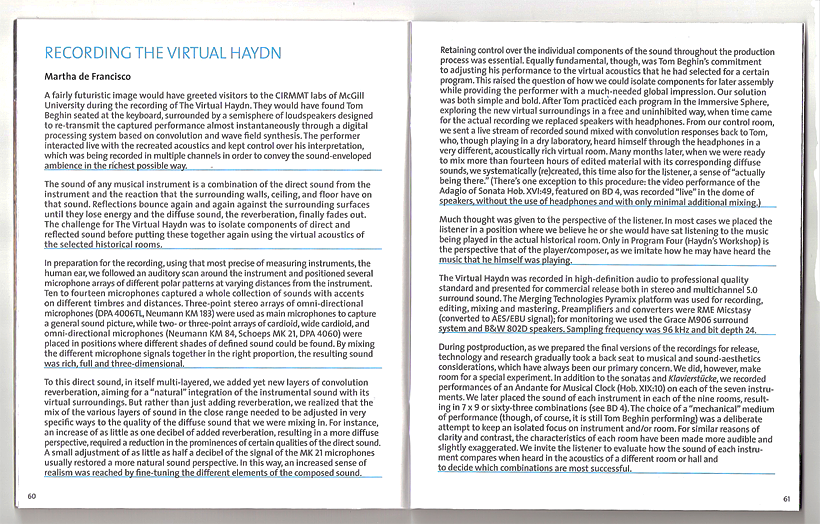|
Audio Production
--- San Franciso Symphony
--- CHANNEL CLASSICS --- McGill
University --- Pentatone Classics
--- DGG --- RR
---
DSD streaming ---
Recording in a virtual acoustic space
The Virtual Haydn: Complete Works
for Solo Keyboard
( Four Blu-Ray discs from NAXOS, www.thevirtualhaydn.com )

Haydn's Sonatas and Klavierstuecke were played on seven historical keyboards, specially built by four renowned
master-artisans, and played in nine virtual rooms, precisely mapped and
recreated from impulse response measurements of rooms, in which Haydn's music
would have been played. The source for the impulse response measurements was not
a popped balloon or pistol shot, but a slow frequency sweep of a cluster of
loudspeakers, covering different parts of the frequency range and aiming in
different directions from the instrument location. Thus the source illuminated
the room more like a musical instrument, having directional characteristics.
(e.g. Juergen Meyer, Acoustics and the Performance of Music, Springer
2009). An array of microphones was used to record the frequency sweep in
different locations of the room, leading to a large number of room impulse
responses. For recording the keyboard was set up in an acoustically dead room,
surrounded by a dome of 24 loudspeakers, which reproduced the acoustic response
to the sound of the keyboard in any of the chosen nine rooms, thus allowing the
musician to adjust his style and timing as if playing in the real room.
When the recording is rendered in stereo over LX512 loudspeakers a differentiated and
believable aural scene is created for the different combinations of instruments
and venues. The loudspeakers and listening room disappear, leaving an enjoyable
illusion of a historic keyboard in various rooms. It is not possible to confirm
how closely the recording in the virtual room can match the sound in the real
room, because the DVD does not provide such tracks. I recommend to first view
and listen to all of DVD #4 for greater appreciation of this interesting
recording project.
Virtual Acoustic Technology Lab
Recording Multichannel Sound within Virtual Acoustics
Active Acoustics in Concert Halls - A New Approach
Wieslaw
Woszczyk
------------------------------------------------------------------------------
|